工业工程专业英语 周跃进 第二章
- 格式:ppt
- 大小:452.50 KB
- 文档页数:43
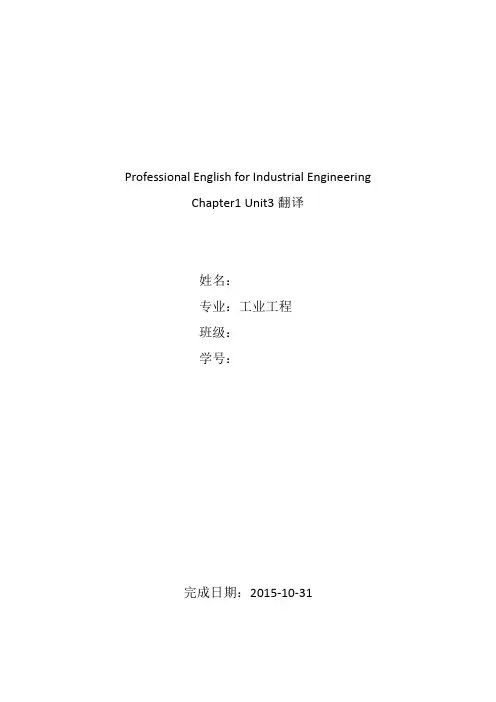
Professional English for Industrial EngineeringChapter1 Unit3翻译姓名:专业:工业工程班级:学号:完成日期:2015-10-31Chapter 1Unit 3 Academic Disciplines of Industrial Engineering五大主要工程学科和它们的发展在美国,有五个主要工程学科(土木、化学、电工、工业、机械),它们是早在第一次世界大战时就出现的工程分支学科。
这些进步是世界范围内发生的工业革命的一部分,并且在技术革命的开始阶段仍在发生。
随着第二次世界大战的发展导致了其他工程学科的发展,比如核工程,电子工程,航空工程,甚至是电脑工程。
太空时代导致了航空工程的发展。
最近对环境的关注使得环境工程和生态工程也得到了发展。
这些更新的工程学科经常被认为是专长学科包含“五大”学科,即土木,化学,电工,工业,和机械工程里的一种或多种。
和美国的情况不同,工业工程在中国属于第一层级管理科学和工程学科下面的第二级别的学科。
IE学科的开端学科后来演变成工业工程学科是最初在机械工程系被作为特殊课程教的。
首个工业工程的分部在1908年的宾夕法尼亚州大学和雪城大学被建立。
(在宾夕法尼亚州的项目是短期存在的,但是它在1925年又重建了)一个在普渡大学的机械工程的IE选科在1911年被建立。
一个更完整的工业工程学院项目的历史可能在资料中被找到。
在机械工程部有一个IE选科的实践是主要的模式直到第二次世界大战的结束,并且分离出来的IE部在整个上个世纪里的文理学院和综合大学里被建立。
早在第二次世界大战的时候,在工业工程方面,只有很少的毕业生水平的研究。
一旦分开的学部建立之后,学士和博士级别的项目开始出现。
现代IE的教育—分支学科今天,与过去相比,工业工程对于不同的人来说意味着不同的东西。
实际上,一个发展一个突出的现代工业工程的方法是通过获得在它的分支学科和它怎么联系到其他领域的理解。
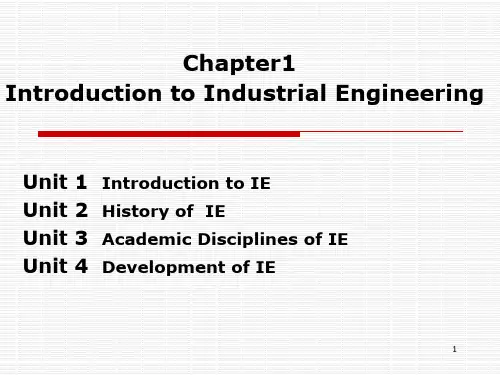
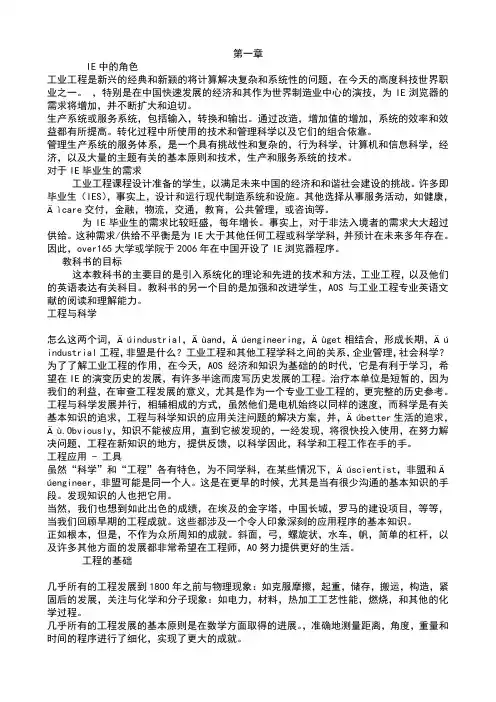
第一章IE中的角色工业工程是新兴的经典和新颖的将计算解决复杂和系统性的问题,在今天的高度科技世界职业之一。
,特别是在中国快速发展的经济和其作为世界制造业中心的演技,为IE浏览器的需求将增加,并不断扩大和迫切。
生产系统或服务系统,包括输入,转换和输出。
通过改造,增加值的增加,系统的效率和效益都有所提高。
转化过程中所使用的技术和管理科学以及它们的组合依靠。
管理生产系统的服务体系,是一个具有挑战性和复杂的,行为科学,计算机和信息科学,经济,以及大量的主题有关的基本原则和技术,生产和服务系统的技术。
对于IE毕业生的需求工业工程课程设计准备的学生,以满足未来中国的经济和和谐社会建设的挑战。
许多即毕业生(IES),事实上,设计和运行现代制造系统和设施。
其他选择从事服务活动,如健康,Äìcare交付,金融,物流,交通,教育,公共管理,或咨询等。
为IE毕业生的需求比较旺盛,每年增长。
事实上,对于非法入境者的需求大大超过供给。
这种需求/供给不平衡是为IE大于其他任何工程或科学学科,并预计在未来多年存在。
因此,over165大学或学院于2006年在中国开设了IE浏览器程序。
教科书的目标这本教科书的主要目的是引入系统化的理论和先进的技术和方法,工业工程,以及他们的英语表达有关科目。
教科书的另一个目的是加强和改进学生,AOS与工业工程专业英语文献的阅读和理解能力。
工程与科学怎么这两个词,Äúindustrial,Äùand,Äúengineering,Äùget相结合,形成长期,Äúindustrial工程,非盟是什么?工业工程和其他工程学科之间的关系,企业管理,社会科学?为了了解工业工程的作用,在今天,AOS经济和知识为基础的的时代,它是有利于学习,希望在IE的演变历史的发展,有许多半途而废写历史发展的工程。
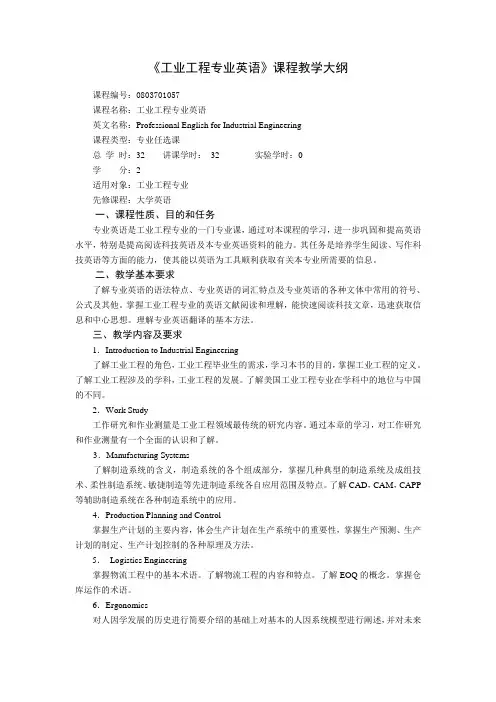
《工业工程专业英语》课程教学大纲课程编号:0803701057课程名称:工业工程专业英语英文名称:Professional English for Industrial Engineering课程类型:专业任选课总学时:32 讲课学时:32 实验学时:0学分:2适用对象:工业工程专业先修课程:大学英语一、课程性质、目的和任务专业英语是工业工程专业的一门专业课,通过对本课程的学习,进一步巩固和提高英语水平,特别是提高阅读科技英语及本专业英语资料的能力。
其任务是培养学生阅读、写作科技英语等方面的能力,使其能以英语为工具顺利获取有关本专业所需要的信息。
二、教学基本要求了解专业英语的语法特点、专业英语的词汇特点及专业英语的各种文体中常用的符号、公式及其他。
掌握工业工程专业的英语文献阅读和理解,能快速阅读科技文章,迅速获取信息和中心思想。
理解专业英语翻译的基本方法。
三、教学内容及要求1.Introduction to Industrial Engineering了解工业工程的角色,工业工程毕业生的需求,学习本书的目的,掌握工业工程的定义。
了解工业工程涉及的学科,工业工程的发展。
了解美国工业工程专业在学科中的地位与中国的不同。
2.Work Study工作研究和作业测量是工业工程领域最传统的研究内容。
通过本章的学习,对工作研究和作业测量有一个全面的认识和了解。
3.Manufacturing Systems了解制造系统的含义,制造系统的各个组成部分,掌握几种典型的制造系统及成组技术、柔性制造系统、敏捷制造等先进制造系统各自应用范围及特点。
了解CAD,CAM,CAPP 等辅助制造系统在各种制造系统中的应用。
4.Production Planning and Control掌握生产计划的主要内容,体会生产计划在生产系统中的重要性,掌握生产预测、生产计划的制定、生产计划控制的各种原理及方法。
5.Logistics Engineering掌握物流工程中的基本术语。
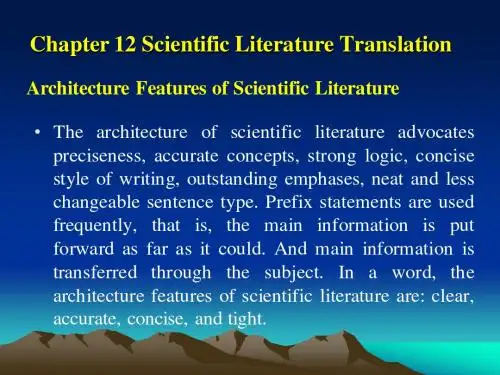
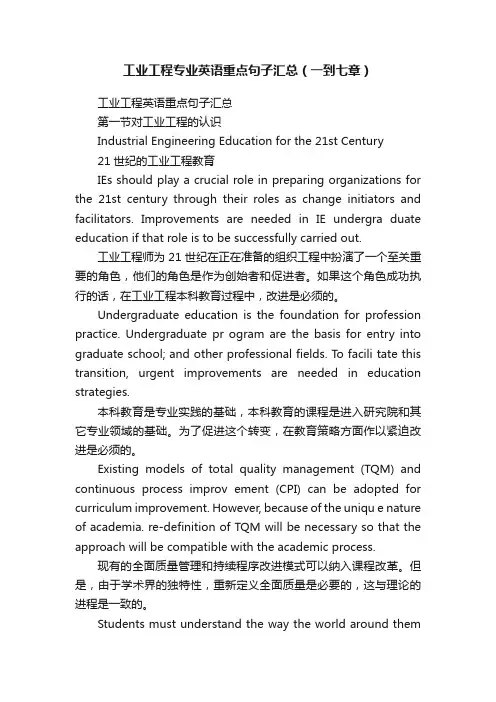
工业工程专业英语重点句子汇总(一到七章)工业工程英语重点句子汇总第一节对工业工程的认识Industrial Engineering Education for the 21st Century21世纪的工业工程教育IEs should play a crucial role in preparing organizations for the 21st century through their roles as change initiators and facilitators. Improvements are needed in IE undergra duate education if that role is to be successfully carried out.工业工程师为21世纪在正在准备的组织工程中扮演了一个至关重要的角色,他们的角色是作为创始者和促进者。
如果这个角色成功执行的话,在工业工程本科教育过程中,改进是必须的。
Undergraduate education is the foundation for profession practice. Undergraduate pr ogram are the basis for entry into graduate school; and other professional fields. To facili tate this transition, urgent improvements are needed in education strategies.本科教育是专业实践的基础,本科教育的课程是进入研究院和其它专业领域的基础。
为了促进这个转变,在教育策略方面作以紧迫改进是必须的。
Existing models of total quality management (TQM) and continuous process improv ement (CPI) can be adopted for curriculum improvement. However, because of the uniqu e nature of academia. re-definition of TQM will be necessary so that the approach will be compatible with the academic process.现有的全面质量管理和持续程序改进模式可以纳入课程改革。
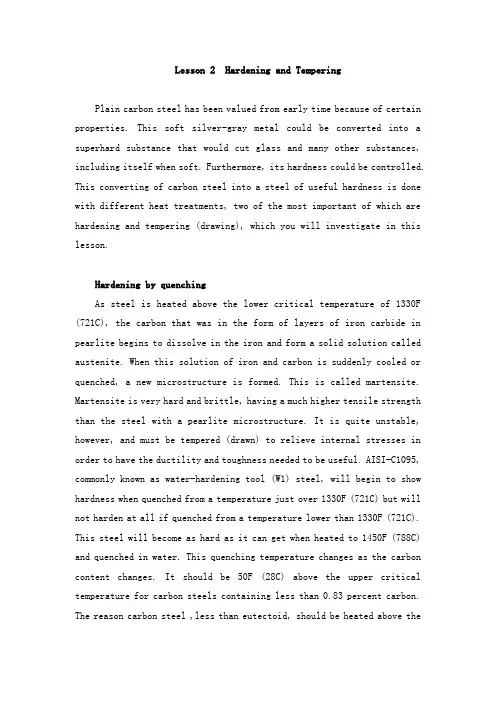
Lesson 2 Hardening and TemperingPlain carbon steel has been valued from early time because of certain properties. This soft silver-gray metal could be converted into a superhard substance that would cut glass and many other substances, including itself when soft. Furthermore, its hardness could be controlled. This converting of carbon steel into a steel of useful hardness is done with different heat treatments, two of the most important of which are hardening and tempering (drawing), which you will investigate in this lesson.Hardening by quenchingAs steel is heated above the lower critical temperature of 1330F (721C), the carbon that was in the form of layers of iron carbide in pearlite begins to dissolve in the iron and form a solid solution called austenite. When this solution of iron and carbon is suddenly cooled or quenched, a new microstructure is formed. This is called martensite. Martensite is very hard and brittle, having a much higher tensile strength than the steel with a pearlite microstructure. It is quite unstable, however, and must be tempered (drawn) to relieve internal stresses in order to have the ductility and toughness needed to be useful. AISI-C1095, commonly known as water-hardening tool (W1) steel, will begin to show hardness when quenched from a temperature just over 1330F (721C) but will not harden at all if quenched from a temperature lower than 1330F (721C). This steel will become as hard as it can get when heated to 1450F (788C) and quenched in water. This quenching temperature changes as the carbon content changes. It should be 50F (28C) above the upper critical temperature for carbon steels containing less than 0.83 percent carbon. The reason carbon steel ,less than eutectoid, should be heated above theupper critical temperature is that the ferrite is not all transformed into austenite below this point, and when quenched, is retained in the martensitic structure. The retained ferrite causes brittleness even after tempering.Low carbon steels such as AISI 1020 will not, for all practical purpose, harden when they are heated and quenched. Oil- and air-hardening steels have a higher hardenability and do not have to be quenched as rapidly as plain carbon steels. Consequently, they are deeper hardening than water hardening types, which must be cooled to 200F within 1 or 2 seconds. Plain carbon steels containing 0.83 percent carbon can get as hard (RC67) as any plain carbon steel containing more carbon.TemperingTempering, or drawing, is a process of reheating a steel part that has been previously hardened to transform some of the hard martensite into softer structures. The higher the tempering temperature used, the more martensite is transformed, and the softer and tougher (less brittle) the piece becomes. Therefore, tempering temperatures are specified according to the strength and ductility desired. Mechanical properties charts, which may be found in steel manufacturers’handbooks and catalogs, give these data for each type of alloy steel.A part can be tempered in a furnace or oven by bringing it to the required temperature and holding it there for a length of time, then cooling it in air or water. Some tool steels should be cooled rapidly after tempering to avoid temper brittleness.Tempering should be done as soon as possible after hardening. The part should not be allowed to cool completely, since untempered it contains very high internal stresses and tends to split or crack. Tempering will relieve the internal stresses. A hardened part left overnight without tempering may develop cracks by itself.New words 学习1.hardening 淬火2.temper 回火3.convert 转变4.value 重视,尊重……Notes1. This soft silver-gray metal could be converted into a superhard substance that would cut glass and many other substances, including itself when soft.这种银灰色的软金属能够转变成一种超硬的物质,该物质可以切削玻璃和许多其它物质,包括处于软状态时的该金属本身。
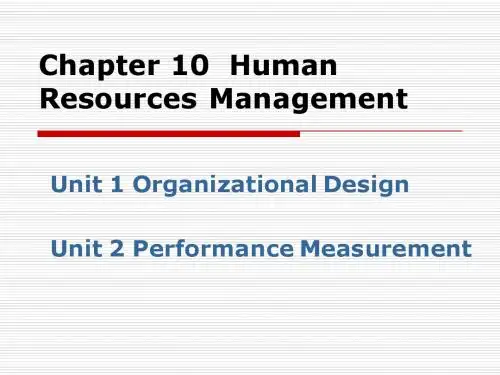
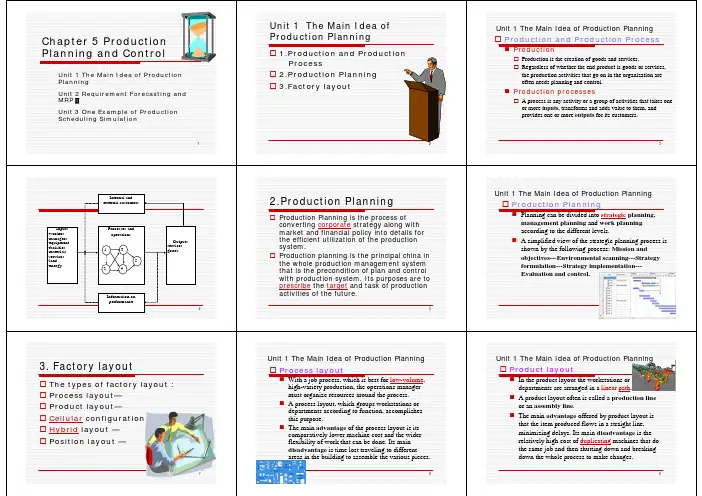
6Unit 1 The Main Idea of Production PlanningProduction PlanningPlanning can be divided into strategic planning , management planning and work planning according to the different levels.A simplified view of the strategic planning process is shown by the following process: Mission and objectives---Environmental scanning---Strategy formulation---Strategy implementation---Evaluation and control.7configuration 8Unit 1 The Main Idea of Production Planning Process layoutWith a job process, which is best for low-volume , high-variety production, the operations manager must organize resources around the process. A process layout, which groups workstations or departments according to function, accomplishes this purpose.The main advantage of the process layout is its comparatively lower machine cost and the wider flexibility of work that can be done. Its main disadvantage is time lost traveling to different areas in the building to assemble the various pieces.Unit 1 The Main Idea of Production PlanningIn the product layout the workstations or path .production line offered by product layout is that the item produced flows in a straight line,11Unit 1 The Main Idea of Production Planning Hybrid layoutA hybrid layout uses an intermediate strategy, in which some portion s of the facility are arranged in a process layout and other arranged in a product layout.Fixed position layoutThis arrangement the product is fixed in place,workers along with their tools and equipment, come to the product to work on it.13Unit 1 The Main Idea of Production Planning Factory Layout and Planning ActivitiesMachines and AccessoriesNew Types of Factory LayoutThree approaches to layout design address three distinctneeds of the flexible factory.The first two approaches present novel layout configurations,namely distributed and modular layout.In the third approach, we use operational performance as adesign criterion to generate what term agile layout.Designing the forecasting system20Unit 2 Manufacturing Resources Planning 2 Master Production SchedulingThe mater production scheduling is effectively the company has developed for production, staffing , inventory, etc.The production plan may be broken down into several component parts:The master production scheduling (MPS)The material requirements planning (MRP) system The detailed job shop schedules.At the heart of the production plan are the forecasts of demand for the end items produced over the planning horizon .Manufacturing Resource Planning 23retail complicated because some components may be subject to both dependent and independent demand.Unit 2 Manufacturing Resources Planning Benefits of Material Requirements 26Unit 2 Manufacturing Resources Planning Manufacturing Resource Planning (MRP II)MRP II includes the following four major developments from MRP:Resource Scheduling Software Extension Programs30Competitors are gaining by using a new New technologies are available.31Production Process Control Options Traditional Batch Production : Performance Measures :32circular nature 33SummaryUnit 1 The Main Idea of Production PlanningUnit 2 Requirement Forecasting and MRP ⅡUnit 3 One Example of Production Scheduling Simulation。
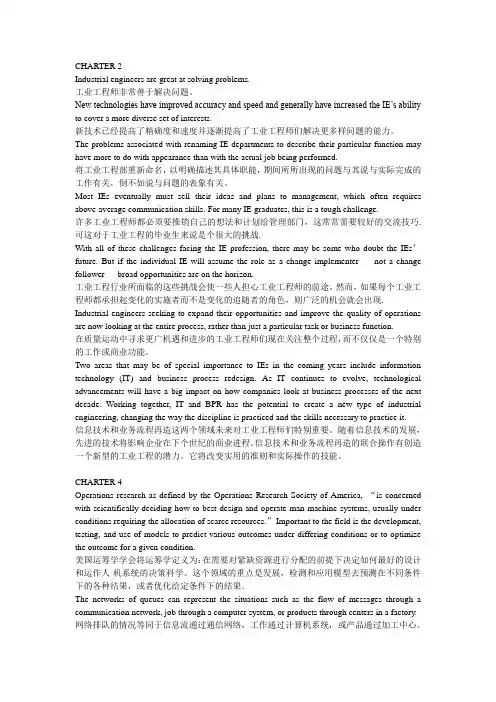
CHARTER 2Industrial engineers are great at solving problems.工业工程师非常善于解决问题。
New technologies have improved accuracy and speed and generally have increased the IE’s ability to cover a more diverse set of interests.新技术已经提高了精确度和速度并逐渐提高了工业工程师们解决更多样问题的能力。
The problems associated with renaming IE departments to describe their particular function may have more to do with appearance than with the actual job being performed.将工业工程部重新命名,以明确描述其具体职能,期间所所出现的问题与其说与实际完成的工作有关,倒不如说与问题的表象有关。
Most IEs eventually must sell their ideas and plans to management, which often requires above-average communication skills. For many IE graduates, this is a tough challenge.许多工业工程师都必须要推销自己的想法和计划给管理部门,这常常需要较好的交流技巧.可这对于工业工程的毕业生来说是个很大的挑战.With all of these challenges facing the IE profession, there may be some who doubt the IEs’future. But if the individual IE will assume the role as a change implementer --- not a change follower --- broad opportunities are on the horizon.工业工程行业所面临的这些挑战会使一些人担心工业工程师的前途。
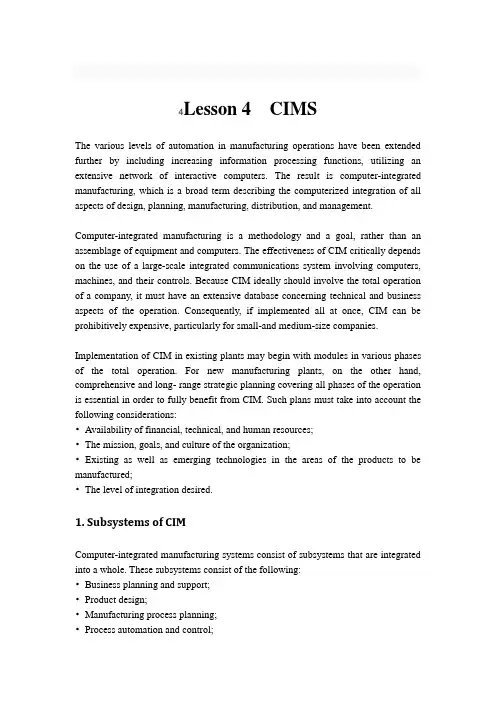
4Lesson 4 CIMSThe various levels of automation in manufacturing operations have been extended further by including increasing information processing functions, utilizing an extensive network of interactive computers. The result is computer-integrated manufacturing, which is a broad term describing the computerized integration of all aspects of design, planning, manufacturing, distribution, and management.Computer-integrated manufacturing is a methodology and a goal, rather than an assemblage of equipment and computers. The effectiveness of CIM critically depends on the use of a large-scale integrated communications system involving computers, machines, and their controls. Because CIM ideally should involve the total operation of a company, it must have an extensive database concerning technical and business aspects of the operation. Consequently, if implemented all at once, CIM can be prohibitively expensive, particularly for small-and medium-size companies.Implementation of CIM in existing plants may begin with modules in various phases of the total operation. For new manufacturing plants, on the other hand, comprehensive and long- range strategic planning covering all phases of the operation is essential in order to fully benefit from CIM. Such plans must take into account the following considerations:•Availability of financial, technical, and human resources;•The mission, goals, and culture of the organization;•Existing as well as emerging technologies in the areas of the products to be manufactured;•The level of integration desired.1. Subsystems of CIMComputer-integrated manufacturing systems consist of subsystems that are integrated into a whole. These subsystems consist of the following:•Business planning and support;•Product design;•Manufacturing process planning;•Process automation and control;•Shop floor monitoring systems.The subsystems are designed, developed, and implemented in such a manner that the output of one subsystem serves as the input of another subsystem. Organizationally, these subsystems usually are divided into two functions.•Business planning functions: These include activities such as forecasting, scheduling, material-requirements planning, invoicing, and accounting.•Business execution functions: include production and process control, material handling, testing, and inspection of the systemThe major benefits of CIM are as follows•Emphasis on product quality and uniformity, as implemented through better process control•Efficient use of materials, machinery, and personnel and major reduction of work-progress inventory, all of which improve productivity and lower product cost. •Total control of the production, schedules, and management of the entire manufacturing operation.•Responsiveness to shorter product life cycles, changing market demands, and global competition.2. DatabaseAn efficient computer-integrated manufacturing system requires a single database to be shared by the entire manufacturing organization. Database consist of up-to-date, detailed, and accurate information relating to products, designs, machines, processes, Materials, production, finances, purchasing, sales, marketing, and inventory. This vast array of data stored in computer memory and recalled or modified as necessary either by individuals in the organization or by the CIM system itself, while it is controlling various aspects of design and production.A database generally consists of the following items, some of which are classified as technical and others as nontechnical.•Product data: Part shape, dimensions, and specifications.•Data management attributes: Revision level and part number.•Production data: Manufacturing processes used.•Operational data: Scheduling, lot sizes, and assembly requirements.•Resources data: Capital, machines, equipment, tooling, and personnel. and their capabilities.Databases are built by individuals and by the use of various sensors in the production machinery and equipment. Data are collected automatically by a data-acquisition system (DAS), which can report the number of parts being produced per unit of time, their dimensional accuracy, surface finish, weight, and other characteristics at specified rates of sampling.The components of DAS include microprocessors, transducers, and analog-to-digital converters (ADCs). Data-acquisition systems are also capable of analyzing the data and transferring them to other computers for purposes such as statistical analysis, data presentation, and the forecasting of product demand.Several factors are important in the use and implementation of databases.•They should be timely, accurate, easily accessible, easily shared, and user-friendly. •Because it is used for various purposes and by many people, the database must be flexible and responsive to the needs of different uses.•CIM systems can be accessed by designers, manufacturing engineers, planners, financial officers, and the management of the company by using appropriate access codes. Of course, companies must protect data against tampering or unauthorized use. •If there are problems with data accuracy, the correct data should be recovered and restored.3. The CIM WheelThe Computer and Automated Systems Association (CASA) of the Society of/Manufacturing (SME) developed the CIM wheel (Figure 4.1) as a way to comprehensively but concisely illustrate the concept of CIM. The CASA/SME developed the CIM wheel to include several distinct components:•Manufacturing management/human resource management;•Marketing;•Strategic planning;•Finance;•Product/process design and planning•Manufacturing planning and control;•Factory automation.CIMS课各种级别的自动化生产业务进一步扩展了包括增加信息处理功能,利用广泛的交互式计算机网络。
第一章:Several educators have recognized that the way engineering is practiced has changed dramatically o ver the year and an upgrade is needed in engineering education.很多教育者已经意识到工程教育实施的这种方式在很多年中有了很大的变化,并且意识到工程教育中的改善是必要的。
IE should take the lead in reforming its own curriculum so that it can help to developed practical imp lementation models that can be used by other disciplines.工业工程应该率先改革其自身专业,这样就有助于产生出可以运用在其他学科的可行性的实践模式Incorporation quality concepts into education is a goal that should be pursued at national, state, loca l and institution levels.将质量理念融入到教育之中是民族,国家,地区甚至是协会标准的追求目标Interdisciplinary course and curriculum improvement should link separate but related subjects to pro vide students with comprehensive skills so they can adapt to the changing world.交叉学科和课程改进应该把那些虽然不同但是有关的课题联系起来,以便为学生提供广泛的技能使他们能够适应变化的社会。
第一章:应力与应变1.That branch of scientific analysis which motions, times and forces is called mechanics and is made up of two parts, statics and dynamics.研究位移、时间和力运动乘力是科学分析法的一个分歧,被称作力学,力学由两大部分组成,静力学和动力学。
2.For example, if the force operating on a sleeve bearing becomes too high, it will squeeze out the oil film and cause metal-to-metal contact, overheating and rapid failure of the bearing.例如:如果止推轴承上的作用力过大的话,会挤出油膜,引起金属和金属之间的相互接触,轴承将过热而迅速失效。
3.Our intuitive concept of force includes such ideas as place of application, direction, and magnitude, and these are called the characteristics of a force.力的直观概念包括力的作用点、大小、方向,这些被称为力的三要素。
4.All bodies are either elastic or plastic and will be deformed if acted upon by forces. When the deformation of such bodies is small, they are frequently assumed to be rigid, i.e., incapable of deformation, in order to simplify the analysis.所有的物体既可以是弹性的也可以是塑性的,如果受到力的作用就产生变形。
工业工程专业英语复习资料(修正版)一、句子翻译:1. A production system or service includes inputs, transformation, and outputs. Through transformation, the added values are increased and system efficiency and effectiveness are improved.2. Industrial engineering emerged as a profession as result of the industrial revolution and the accompanying need for technically trained people who could plan, organize, and direct the operations of large complex systems.3. Taylor's original contribution, constituting the beginning of industrial engineering, was his three-phase method of improving efficiency: Analyze and improve the method of performing work, reduce of times required, and set standards for what the times should be.4. Some operations research problems involve a large number of equations -some linear programming solutions, for example-but the complexities of representation in any one of the many equations may, and often do, make the entire set of equations unsolvable.5. The machine to an industrial engineer is a black box that has a production rate, yield rate, required operator skills, process capabilities, and other production system attributes.6. The industrial engineering responsibility involves the integration of workers, machines, materials, information, capital, and managerial know-how into a producing system that will produce the right product, at the right cost, at the right time.7. Process analysis is one of the main contents of method study, by which researchers can completely observe and record the whole production processes and carry out integrated analysis form a macroscopic viewpoint.8. With today's increasing competition from foreign producers, there has been an increasing effort to establish standards based on facts rather than judgment.9. Accurately establish time standards make it possible to produce more within a given plant, thus increasing the efficiency of the equipment and the operating personnel. Poorly established standards, although better than no standards at all, lead to high cots, labor dissension, and possibly even the failure of enterprise10. A process is any activity or a group of activities that takes one or more inputs, transforms and adds value to them, and provides one or more outputs for its customers.11. Production Planning is the process of converting corporate strategy along with market and financial policy into details for the efficient utilization of the production system.12. A simplified view of the strategic planning process is shown by the following process: Mission and objectives 一Environmental scanning —Strategy formulation 一Strategy implementation-^Evaluation and control.13. The main advantage of the process layout is its comparatively lower machine cost and wider flexibility of work that can be done. Its main disadvantage is time lost traveling to different areas in the building to assemble the various pieces.14. The Council of Logistics Management defined the logistics in 1992 as the process of planning, implementing an controlling the efficient, flow and storage of goods, services, and related information from point of origin to point of consumption the purpose of conforming to customer requirements.15. The theory of logistics engineering is the study of analyzing, designing, optimizing and controlling the logistics system as a whole. It utilizes the methods of the industrial engineering and systems engineering. The study of logistics is of great importance in the production practice.16. Ergonomics is scientific discipline concerned with the understanding of interactions among humans and other elements of a system, and the profession that applies theory, principles, date and methods to design in order to optimize human being activities and overall system performance.17. Ergonomics has a wide application to everyday domestic situations, but there areeven more significant implications for efficiency, productivity safety and health in work settings.18. Engineering Psychology is defined as the application of psychological principles, knowledge, and research to improve the ability of humans to operate more effectively in a technological society.19. Accurately established time standards make it possible to produce more within a given plant, thus increasing the efficiency of the equipment and the operating personnel. Poorly established standards, although better than no standards at all, lead to high costs, labor dissension, and possibly even the failure of the enterprise.1.assembly line 装配线2.batch production 批量生产3.cell production 单元生产4.CIM (Computer Integrated Manufacturing)计算机集成制造5.economic batch quantity 经济孔匕量6.FMS (Flexible Manufacturing Systems)柔性制造系统7.gang process analysis 联合操作分析8.Manufacturing Resource Planning (MRP 11)制造资源计划9.Material Requirements Planning (MRP)物料需求计划10.operation analysis 操作分析11.process analysis 程序分析12.process layout 工艺式布局13.product layout 品式布局14.production 1 ine生产线、流水线15.production planning 生产计划16.TQM (Total Quality Management)全面质量管理17.work in process 在制品18.work measurement 作业测定19.work sampling technique 工作抽样技术。
Chapter 1 工业工程简介Unit 1 工业工程简介工业工程的角色作为一种古老和新颖的专业之一,工业工程的出现将用来解决当今高度技术发展的世界所遇到的复杂的系统问题。
尤其是随着中国经济的快速发展,中国扮演着世界制造工业的中心的角色,对工业工程的要求将持续迫切地增加和扩展。
一个生产系统或服务系统包括输入、转换和输出。
通过转换,提高了附加值,改善了系统的效率和效果。
转换的进程依赖于使用的技术和科学的管理以及两者的结合。
管理一个生产系统和服务系统是一个具有挑战性的复杂的任务。
它需要基本的科学、工程学、行为学、计算机信息科学、经济学和关于生产和服务系统基本规律与技术的大量课题等方面的知识。
工业工程毕业生的需求工业工程这门课程被设计用来使学生适应构建中国经济与和谐社会的未来的挑战。
的确,许多工业工程毕业生将设计和管理现代制造系统和设施。
其他的将选择致力于像健康保健、金融业、后勤物流、运输、教育学、公共管理或咨询行业等服务领域。
本书目标本书的主要目的是介绍系统的理论和先进的技术以及工业工程的相关科目和它们的英语表达的方法。
本书的另一个目的是强化和提高学生们阅读和理解与工业工程有关的专业化英语文献的能力。
工程与科学“工业的”和“工程”这两个词是怎样结合起来形成“工业工程”的?工业工程和其他工程学科以及商务管理和社会科学之间是什么关系?为了理解工业工程在当今的经济和基于知识的时代中所扮演的角色,了解在工业工程进化过程中有希望的历史发展是有益的。
有许多方法来书写工业工程的历史发展。
因为我们的兴趣是回顾工程发展的意义,尤其是那些把工业工程引导成为一个专业的意义,所以在本单元的介绍只做了简单的处理。
我们可以从参考文献中得到更多关于工业工程发展的完整历史。
虽然工程和科学的发展步调一直都不同,但是他们却是以并行、互补的形式发展起来的。
工程关系到对问题的解决和对“更好的生活”的要求的科学知识的应用,然而,科学却关系到对基本知识要求。